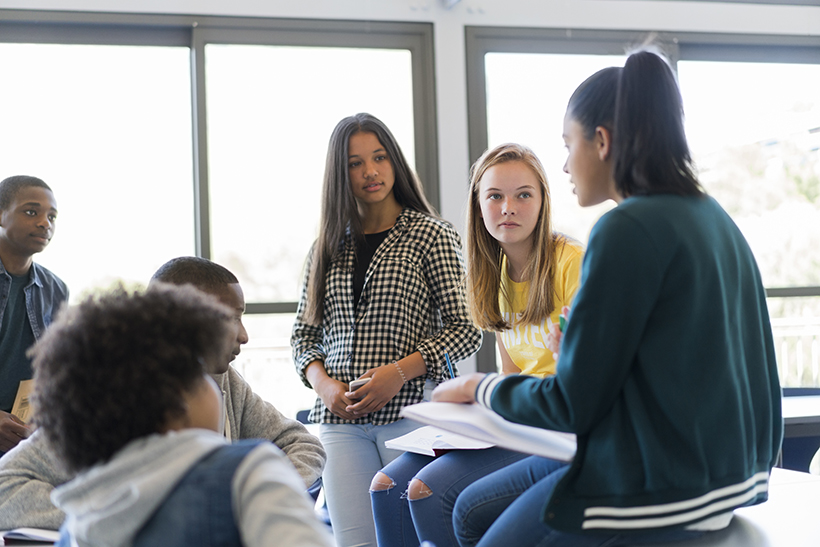This blog was written by NCTE member Trevor Aleo.
If I were to tell you that stories are all around us, you probably wouldn’t find me very original. It’s one of those clichés that has undoubtedly been printed on a poster in a fancy downloadable script font with a magisterial sunset backdrop—if you’ve spent any time on Etsy, you’ll know what I mean. 
But despite its cliché origins, I believe that if we get intentional about teaching the concepts and structures that define all stories, as opposed to only discussing the ones we read in class, we can truly make literature come alive for our students.
Luckily for us, we teach in the golden age of narrative. Though the media are varied, our students obsessively consume, curate, and create stories. Whenever they sit down to binge watch the latest Netflix series, see a comic book movie in theaters, listen to Drake’s latest album, play videogames, or even create Snapchat and Instagram stories to share with their friends, they are engaging with the power of storytelling. Only they have absolutely no idea.
As educators, we’re intimately familiar with the rich architecture of storytelling that informs modern entertainment. Our students, however, are more preoccupied with the media through which their stories are conveyed. Unless given the chance to draw connections, they don’t realize that their knowledge of Thanos can help them better understand the motivations driving Macbeth. Or that, just like Lord of the Flies, The Walking Dead explores what happens when the trappings of civilization disappear and we’re left to contend with our innate savagery. Or that Get Out is born from W. E. B. Dubois’s writings, that tween dystopian movies pull from 1984, and that Kanye could teach us a thing or two about hubris.
We need to stop treating prior knowledge like a side dish and use it more intentionally.
That’s why my tenth-grade teammates and I make a point to devote time to drawing connections and consolidating schema, to help our students see that these ideas from English class are, in fact, all around them.
Here are three quick steps to start capitalizing on student’s prior narrative knowledge:
- Devote time to exploring “big idea” concepts before starting new units.
Consider how broader ideas like truth, power, identity, and purpose appear in a wide variety of narratives. Facilitate discussions, complete activities, do experiential games, and so on, to foster a baseline mental model of the concept. The knowledge gained from this step will serve as a conceptual launching pad for when students must grapple with these ideas in more complex texts. Literature is a great tool to convey aspects of the human condition, but if students struggle with the text in which it’s presented, they have no hope of understanding its deeper ideas. By exploring these concepts up front, in more concrete terms with a scaffolded activity, you’ll lessen the cognitive load required for students to access them when reading. - Let students engage with a variety of stories exploring those “big idea” concepts.
Once students have begun to develop a mental model of the anchor text’s thematic concepts, afford them some time to explore how that idea looks in other contexts across various periods and genres. This could be as elaborate as a book clubs or as informal as Think/Pair/Shares about relevant pop culture. The important thing is that there is enough variation that they’re able to see past the superficial elements of the story and begin identifying the emerging patterns underneath. If we fail to supply contextual variance, students may understand how ideas like innocence, humanity, and power look in a single narrative but won’t be able to transfer and apply that understanding when they encounter them in new contexts. - Continually discuss the patterns and similarities that emerge.
It’s important to frequently ask students to draw connections throughout the year. Every time they draw a connection, they’re strengthening their understanding of both the text they’re reading in class and its corresponding concept. If this only occurs once, at the beginning of a unit, students won’t be able to carry that understanding all the way through the text. Discussion of these connections must be constant and deliberate. Consider creating physical representations of these schema in your classroom where students can list, record, and draw connections among the stories they encounter throughout the year.
By repeating these steps, my students start recognizing the structural patterns everywhere. Initially, they joke that I have “ruined everything” by turning their favorite media against them. Eventually, literary analysis escapes the confines of my classroom and infects every narrative they ingest: books, movies, TV, even music. Of course, like all superheroes, they eventually realize this “tragedy” will become their cherished superpower.
By years end, they finally understand that the best stories do more than just entertain, they reveal who we truly are.

Trevor Aleo is an English teacher in the DC suburbs. He received his MA in teaching from James Madison University in 2014. He has a passion for innovative teaching practices, finding the intersection between pop culture and pedagogy, and incessantly asking his students “Why?” You can find him pontificating on the state of American culture and education on Twitter @MrAleoSays.

